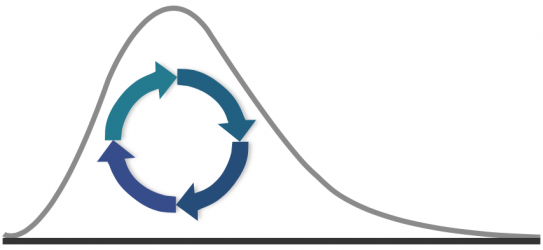I want you and your team to have good retrospectives. Retros are the most important mechanism for continuous improvement. There are so many articles out there with good advice. But I’d like my own anyway and discuss a few concepts.
Method variance (part of facilitation)
As I write this in late March 2020, most of us are WFH – working from home, due to the COVID-19 “Coronavirus”. Eliminating the ability to collaborate face-to-face makes varying the conduct method of your retrospective even more important. This is because the variance subtly motivates different perspectives, and that is an important way we discover new things to try (experiment) to improve. For example, suppose you want to hear from every team member. You can call on everyone in turn as the Scrum Master. You can ask each to choose their successor, you can intentionally randomize. You can ask “who would like to go next?” Each has advantages. Choose a different method for doing business as often as you can. Here is one ‘net resource discussing this idea; here’s another.
Framework variance
Most retrospectives have a framework for engaging in discussion resulting in specific elements of continuous improvement. Vary this too; no matter how inventive it is it gets old with overuse. Start/ Stop/ Continue is great, but there are so many others, some with interesting names like Sailboat, and again each results in different perspectives. Here is a list of 10 different frameworks including Lean Coffee.
Agenda
The agenda for a retrospective is more than just executing the framework. It’s also a look back and of course a look forward. Here is a sample agenda with a beginning, the “meat”, and outcomes:
- Introduction (try the Retrospective Prime Directive)
- Celebrations
- What were the three (no more than 3) behaviors we decided to change last time? How did that go?
- What were the three (again, no more than 3) retrospective backlog items, actions, we decided to work on last time? How did they go?
- Framework choice (see above)
- Framework-based, facilitated retrospective free discussion
- What are the < 3 behaviors we will change for next time?
- What are the < backlog items of continuous improvement we will work on and complete for next time?
- Other remarks / Conclusion
Inputs
- An invitation to meet, with agenda
- Recent behavior changes – let’s call them decisions – we’ve been experimenting with (an example: we decided to do three backlog refinement sessions last sprint instead of two, how did this go?)
- Recent backlog items – actions – associated with retrospectives (an example: we added a Jira issue to build a Slack bot to do (whatever) is this done and how is it working out?)
- Framework choice (or, this might be revealed during the retro session itself)
Guidelines
- Ensure that your retrospectives occur sufficiently often. Less than monthly is almost certainly unacceptable.
- Ensure that the feeling of the session is not that of a report or reports. It is a collaborative discovery session.
- Allow for anonymous input. If you were all in a room together, the next sticky note you place on the wall in conjunction with your framework-based discussion is at least somewhat anonymous. When we discuss it, the person who wrote it may or may not speak up, and if they do they may or may not own up to having written it. Try to encourage this kind of anonymity, as it frees up discussion and makes more innovation possible.
- Take inputs and group them to improve effectiveness. It’s ok for multiple people to say the same thing. Group them after collecting them, to facilitate discussion. The face-to-face method is to grab stickies and group them together. Do what you can if you’re remote to make this happen.
- Take your team’s inputs and prioritize them, at least most of the time – perhaps in the interest of varying method you don’t always do so, but most of the time you should. The Lean Coffee method works fine, most votes is highest priority. Discuss the topics in priority order.
- Have fun! Celebrate!
Outputs
- Those behavioral things we’re going to change and experiment with, that is our decisions, and
- those actions we’re going to work on, and which therefore will appear in our backlog, both of these first two bullets in the name of continuous improvement
- the date/time of the next retrospective
- Don’t forget to celebrate! You need to work that in somewhere.

